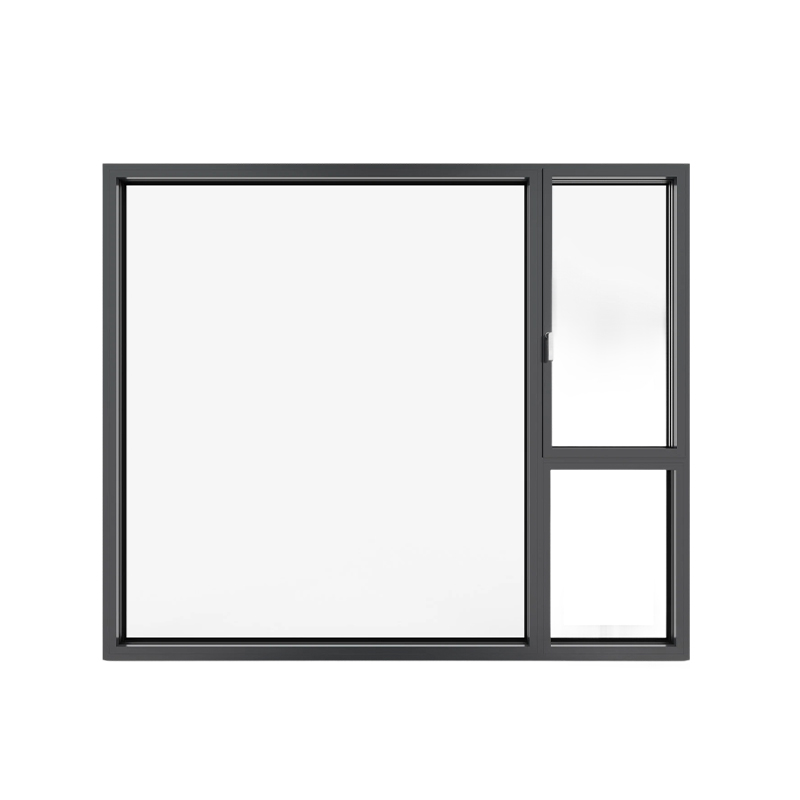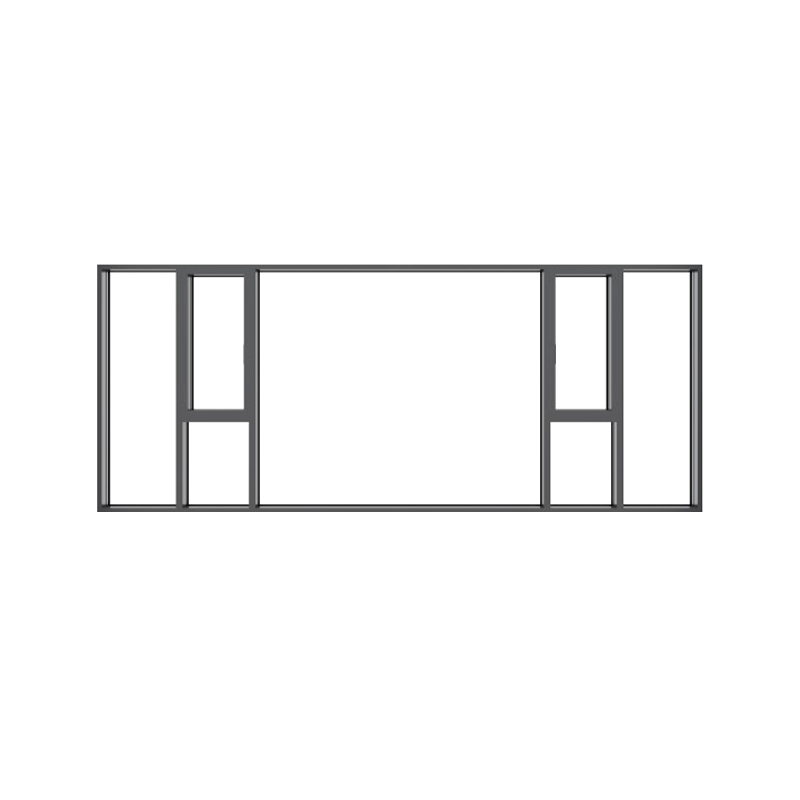Does the thermal insulation design of the low energy consumption external window system significantly block the heat conduction path of the aluminum material itself?
Release Time : 2025-08-28
The thermal insulation design of the low-energy-consumption external window system is a key physical solution in modern building energy-saving technology. Its core mission is to address the heat loss problem caused by the inherent high thermal conductivity of aluminum alloy materials. Without intervention, heat will quickly transfer from the hot side to the cold side through the aluminum profile, forming a so-called "thermal bridge." This causes indoor heat to escape in winter and external heat to enter in summer, increasing the burden on air conditioning and heating systems and potentially causing environmental problems such as condensation and mold. The thermal insulation design was developed precisely to completely block this heat conduction path while preserving the structural advantages of aluminum.
The so-called "thermal bridge" does not refer to a physical break, but rather a layer of non-metallic material with extremely low thermal conductivity, typically reinforced nylon or polyamide composites, embedded within the aluminum alloy profile to form a "thermal insulation strip." This strip-like structure runs across the inner and outer parts of the window frame, interrupting the previously continuous metal path and preventing heat from conducting directly through the aluminum. Heat must first be transferred from the outer aluminum to the insulation strip, and then from the insulation strip to the inner aluminum. Because the thermal resistance of non-metallic materials is much higher than that of metal, this process is significantly delayed, significantly reducing the intensity of the heat flow. This structural "bridge interruption" effectively breaks the linear heat transfer path, separating the aluminum's function from its thermal performance.
The thermal break in a low-energy-consumption external window system is typically located at critical sections of the window frame where thermal bridging is most likely to form, such as the center of the frame, the overlap of the glass edges, or the connection between the opening sash and the fixed frame. The width and position of the insulation strip are precisely calculated to ensure sufficient insulation length to improve thermal resistance while also balancing the overall structural strength of the profile and assembly space. High-quality thermal break design not only blocks lateral heat flow but also considers the effects of heat convection and radiation in complex environments. Additional features such as a multi-cavity structure, a still air layer, and a reflective coating further enhance overall thermal performance. In practice, the thermal insulation effect of the low-energy-consumption external window system is particularly pronounced in environments with large temperature differences between indoor and outdoor. In winter, when it's warm indoors and cold outdoors, the inner surface temperature of traditional aluminum windows often approaches the outdoor temperature, making condensation likely to form on the glass edges or window frames. However, with thermally-insulated external windows, the inner aluminum surface temperature is closer to room temperature, significantly reducing the risk of condensation and improving living comfort. In summer, intense solar radiation and hot air are effectively blocked, reducing cold air leakage and maintaining a stable indoor coolness. This two-way heat flow control enables the building to maintain lower energy consumption throughout its operation year-round.
Furthermore, the thermally-insulated design of the low-energy-consumption external window system works synergistically with the glazing configuration and sealing system to create a complete energy-saving barrier. Even with high-performance insulating or Low-E glass, thermal bridges in the window frame can significantly reduce overall insulation effectiveness. Thermally-insulated technology ensures that the thermal performance of the window frame and glass matches, avoiding the "short board effect" and achieving uniform insulation throughout the entire window.
Ultimately, the thermal insulation design of the low-energy-consumption external window system is more than a simple combination of materials; it embodies the wisdom of architectural physics. Without sacrificing structural performance, it cleverly reshapes the heat flow path, enabling aluminum alloy, a highly thermally conductive material, to meet the stringent requirements of low-energy buildings. Standing silently on the building's surface, like an invisible barrier, it safeguards indoor temperature and comfort, demonstrating the exquisite balance between energy efficiency, durability, and user-friendliness in modern window and door systems.
The so-called "thermal bridge" does not refer to a physical break, but rather a layer of non-metallic material with extremely low thermal conductivity, typically reinforced nylon or polyamide composites, embedded within the aluminum alloy profile to form a "thermal insulation strip." This strip-like structure runs across the inner and outer parts of the window frame, interrupting the previously continuous metal path and preventing heat from conducting directly through the aluminum. Heat must first be transferred from the outer aluminum to the insulation strip, and then from the insulation strip to the inner aluminum. Because the thermal resistance of non-metallic materials is much higher than that of metal, this process is significantly delayed, significantly reducing the intensity of the heat flow. This structural "bridge interruption" effectively breaks the linear heat transfer path, separating the aluminum's function from its thermal performance.
The thermal break in a low-energy-consumption external window system is typically located at critical sections of the window frame where thermal bridging is most likely to form, such as the center of the frame, the overlap of the glass edges, or the connection between the opening sash and the fixed frame. The width and position of the insulation strip are precisely calculated to ensure sufficient insulation length to improve thermal resistance while also balancing the overall structural strength of the profile and assembly space. High-quality thermal break design not only blocks lateral heat flow but also considers the effects of heat convection and radiation in complex environments. Additional features such as a multi-cavity structure, a still air layer, and a reflective coating further enhance overall thermal performance. In practice, the thermal insulation effect of the low-energy-consumption external window system is particularly pronounced in environments with large temperature differences between indoor and outdoor. In winter, when it's warm indoors and cold outdoors, the inner surface temperature of traditional aluminum windows often approaches the outdoor temperature, making condensation likely to form on the glass edges or window frames. However, with thermally-insulated external windows, the inner aluminum surface temperature is closer to room temperature, significantly reducing the risk of condensation and improving living comfort. In summer, intense solar radiation and hot air are effectively blocked, reducing cold air leakage and maintaining a stable indoor coolness. This two-way heat flow control enables the building to maintain lower energy consumption throughout its operation year-round.
Furthermore, the thermally-insulated design of the low-energy-consumption external window system works synergistically with the glazing configuration and sealing system to create a complete energy-saving barrier. Even with high-performance insulating or Low-E glass, thermal bridges in the window frame can significantly reduce overall insulation effectiveness. Thermally-insulated technology ensures that the thermal performance of the window frame and glass matches, avoiding the "short board effect" and achieving uniform insulation throughout the entire window.
Ultimately, the thermal insulation design of the low-energy-consumption external window system is more than a simple combination of materials; it embodies the wisdom of architectural physics. Without sacrificing structural performance, it cleverly reshapes the heat flow path, enabling aluminum alloy, a highly thermally conductive material, to meet the stringent requirements of low-energy buildings. Standing silently on the building's surface, like an invisible barrier, it safeguards indoor temperature and comfort, demonstrating the exquisite balance between energy efficiency, durability, and user-friendliness in modern window and door systems.







